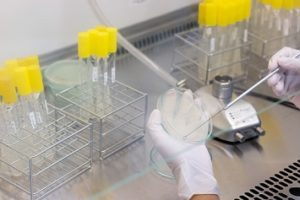Laboratory workers who may be exposed to hazardous chemicals can protect themselves by isolating those chemicals inside a chemical fume hood. Workers exposed to biological agents must also take steps to isolate themselves from infectious hazards with a slightly different type of protective enclosure: a biological safety cabinet (BSC).
Who Needs BSCs?
Infectious agents are categorized as Biosafety Level (BSL) 1, 2, 3, or 4, with BSL 4 agents being the most dangerous. BSCs work in conjunction with safe work practices and procedures to prevent infectious aerosols generated during research from infecting laboratory workers and contaminating the immediate environment; they can also be designed to protect the work against contamination. The protection offered by a BSC is typically at least one step up from a chemical fume hood, because all air that enters a BSC passes through a high-efficiency particulate air (HEPA) filter before it is exhausted or recirculated.
The Right Class of Protection
There are different types of BSCs; it is important to conduct a complete hazard assessment to determine which BSC will provide the needed protection.
- Class I BSCs can be used with low- to moderate-risk pathogens (BSL 1 to BSL 3). They offer partial containment with a front-access opening and constant inward airflow. Class I BSCs protect personnel and the environment but do not protect the work product against contamination.
- Class II BSCs protect not only personnel and the environment but also the work product against contamination. Like Class I BSCs, they are partial-containment systems with front-access openings and constant inward airflow and can be used with low- to moderate-risk pathogens. The airflow pattern in a Class II BSC can be customized to meet the requirements of different kinds of work and to provide protection against particulates, vapors, and gases, making this the most widely used class of BSC.
- Class IV BSCs are used to work with the most dangerous pathogens (BSL 4). They may also be used to work with chemical carcinogens or processes that generate high concentrations of infectious aerosols. They offer total containment and are usually customized to the needs of each specific user.
Safe Work Practices
Basic principles of use for all BSCs include:
- Certification and inspection. Biological safety cabinets must be certified annually and inspected before each use.
- Wear personal protective equipment (PPE). BSCs are not designed to protect workers in the absence of PPE. All appropriate PPE must be identified during the hazard assessment process and worn while the BSC is in use.
- Maintain the airflow. Users must understand how the air flows through their specific cabinet and the work practices they must follow to maintain that airflow. Examples of work practices that are intended to maintain proper airflow include turning on the BSC and allowing it to purge the air for 3 to 5 minutes before beginning work and moving arms in and out of the cabinet slowly to minimize disruption of the air curtain.
- Decontaminate the BSC after use. The BSC must be decontaminated immediately after use. The surfaces of items that are used in the BSC must also be decontaminated before they are removed from the BSC.

